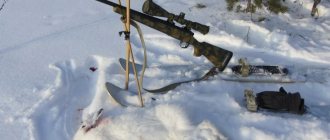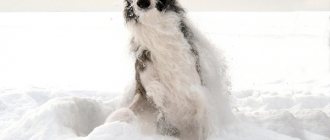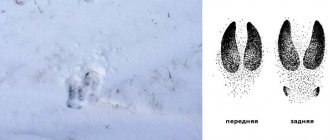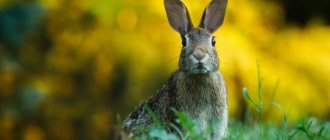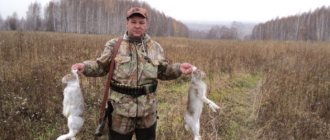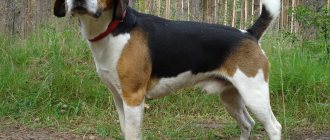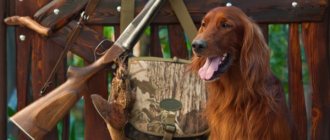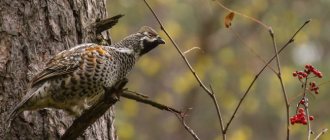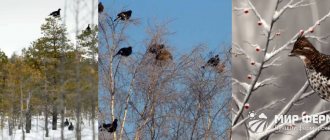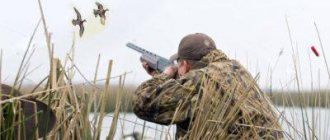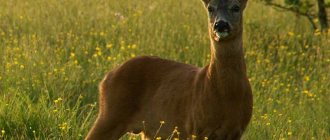Deadlines and a couple of thoughts from myself
They begin hunting hares around mid-autumn and continue until the end of winter. Many regions of the Russian Federation allow you to start fishing long before snow falls.
Of course, tracking is carried out with hounds, because without these four-legged helpers it will not be easy to achieve results. But unfortunately, not every hunter has dogs, but he still wants to get a trophy.
This article will allow you to learn some of the intricacies of the process without a four-legged friend.
Hunting for a hare from ambush
In late autumn and winter, you can hunt a hare from a blind or a storage shed. In this case, a prerequisite is good knowledge of hunting areas. These are, as a rule, fields of winter crops, poorly harvested farmland, and gardens. Traces of a hare can be seen here not only in winter, but also along the black trail. It is also worth hunting near stacks, haystacks or straw - where there is suitable food for the animal.
Choose a place that will be comfortable for long sitting, as well as good from the point of view of shooting, and set up a storage area there in the evening. If you are lucky and the night is moonlit, you will be able to get a good look at the approaching prey and make an accurate shot. Although on such a hunt it is often not possible to even see the hare, which passes a few steps away from you. Plus, trees, bushes and uneven ground cast shadows on the ground that can distract your attention and lead to a missed shot.
But still, hunting from ambush is very interesting, especially at first. Most often you will first hear and only then see the approaching scythe. Especially when the leaves and grass on the ground are already frozen and creaking. But at the same time, the hunter himself must maintain absolute silence - the hare will never approach where suspicious sounds are heard.
More often than not, hares are not strong against wounds, but there are exceptions. Therefore, if you are already hunting in the snow and wounded an animal, it makes sense to follow its trail, perhaps the prey is somewhere nearby. For shooting, as a rule, they use shot No. 3, No. 2 or No. 1, less often – No. 4.
Whatever method of winter hare hunting you choose, remember that this animal fulfills its regulatory role in nature. You should not shoot a lot of game, because next year you will want to return to this activity again, and the campaign will only be successful if there are enough animals in the area.
Black trail hunting is most often hunting for hare in the south of our country. It is also possible to catch a white hare without snow, but such a hunt is called “in the wild”; below we will look at both of these hunts. The hare is hunted both in groups and alone, combing the area in the hope of raising a hare that has settled down on a bed.
Black trail hunting is most often hunting for hare in the south of our country. It is also possible to get a white hare without snow, but this type of hunting is called “Uzerku”; below we will look at both of these hunts.
The hare is hunted both in groups and alone, combing the area in the hope of raising a hare that has settled down on a bed. This hunt cannot be called an easy and pleasant walk; in a day you have to cover a fair number of kilometers through muddy arable land, or get wet through and through while making your way through damp bushes and thick grass. It’s good if the reward is not only a hare glimpsed in the distance, but his weighty carcass that ends up in your backpack after a successful shot.
The hare has his own habits and preferences, sometimes completely incomprehensible to a person, you look for him in the meadow, and he settled down to rest on the bare arable land, the next day you leave your strength, plowing the plowed field, and the hare calmly watches you from the forest belt. But with some skills, you can successfully determine the hare’s resting places. The best solution would be to inspect the fields with strong binoculars from a high place, but, unfortunately, this is not always possible. So, knowing the habits of a hare will greatly increase your chances and will allow you not to waste your energy. He avoids dense forests and simply strong places; in wet weather, you should not look for the hare in thick grass and bushes. He rarely lies down to rest in the places where he lives, but he doesn’t go far from them either, preferring to rest nearby. It will determine the presence of a hare in the field; you can also try to detect its tracks on adjacent roads or the arable land itself.
The hare, unlike its brother, is a forest dweller and it is difficult to just approach it; the hare will probably hear you in advance and leave without even leaving you a chance to look at itself. But nature sometimes plays a cruel joke on him, leaving the hare that has managed to moult without the necessary camouflage. This happens when the snowfall is delayed or the snow that has already fallen has melted. The whitened hare becomes clearly visible from a great distance. Realizing its temporary vulnerability, the hare becomes very careful, trying to leave its bed as little as possible. It becomes quite easy to approach it within shooting distance, as well as to notice the whitened animal against the background of a dark forest. Of course, the hare avoids lying down in open areas at this time; first of all, it is worth examining the trunks of fallen trees, swampy hummocks, in general, places suitable, in his opinion, for playing hide and seek. Moving slowly through the forest, the hunter carefully examines all possible places of hare beds, not only in front, but behind him.
Hunting begins approximately
from mid-autumn and continue until the end. Many regions of the Russian Federation allow you to start fishing long before snow falls.
Of course, tracking is carried out with hounds, because without these four-legged helpers it will not be easy to achieve results
. But unfortunately, not every hunter has dogs, but he still wants to get a trophy.
This article will allow you to learn some of the intricacies of the process without a four-legged friend.
Most often they hunt along the black trail with an approach, since this method is very effective
. They start before the snow falls. To maximize success, it is important to remember the following factors:
- Animal habits;
Days of the big-eared;
It is important that there are a sufficient number of hares in the hunting grounds;
It is necessary that the hunter can walk up to 30 kilometers at a time.
As soon as the hare is about to go for the day, the animal chooses conditions where it can remain unnoticed by the hunter's eyes
or various predators. That is why you need to look for it near small bushes, in a field, near thickets of grass, as well as all kinds of piles of brushwood.
You should not think that in each of these places an animal will be waiting for you. It is important to know where the future trophy rests during the day, because the success of the event depends on it.
It is best to choose calm days
, because this is the time that is most effective. In such weather, hares are more willing to “get up” and move around the area.
Another important point
: It has long been noted that fishing in the rain is often productive. The animal does not like it when drops fall on it, so it tries to avoid thickets and goes for a walk in the open during the day.
Habitats of hares
Uncultivated land (fields) is an excellent area
, to search for the beast. The difficulty is that the hunter does not have the most complete view, but the hare has many chances to hide and go unnoticed.
Since the fields in Russia are large, it is important to have an idea of how best to walk through it, so as not to leave unexplored territory, we recommend walking by “shuttle”
.
The edges of fields are favorite places where hares usually lie down. After all, you can easily hide in the forest in case of danger. Less often, but you can also meet a “slanting” one in an already plowed field, lying on the ground.
Outskirts of villages and agricultural buildings
In the autumn, you can start your search from the outskirts of populated areas or villages. There are many abandoned or rarely used buildings there. These conditions are quiet and calm, allowing the animal to often visit them without being noticed, despite the fact that there is always something to eat there.
- The animal is not afraid, it is difficult to rise
- There are a lot of thickets, buildings and various bushes. This complicates the view and helps the animal
If the hunt will be carried out in an area unknown to you, then use our advice. But if possible, try to study it before the hunt begins, preferably several days in advance, this way the expected routes of the hare will be created.
If you know the area well enough, then you have a rough idea of the number of animals nearby, because this can easily be determined using tracks. Knowing the area is 80% of success.
For example, if you decide to hunt near a pasture, then a lot of food usually accumulates there, which means rodents will come there to feed, including our desired fur-bearing animal. With this type of mining, the first thing you need to do is analyze the surrounding area.
Your task is to find possible places of presence that are able to hide the cautious hare and provide him with food.
Everyone has their own favorite hunts. Some people go on African safaris every year to look for trophy animals, while for others, a holiday is the opportunity to wander through abandoned fields with a gun.
And if such a hunter is lucky enough to see an animal or bird at least from afar, he will remember them for a long time.
Memory will return him to this moment. He will continue to play out all the circumstances, look for reasons for failure or, conversely, for unexpected luck.
So I, like my fellow hunters, return to the past almost every day. I remember past hunts. I summarize, analyze, write down. And now I want to share some experience of difficult, but very interesting and truly sporting hunting for hare. Hunting along the black trail without hunting dogs alone.
Such hunting is common in the southern regions of Russia, where snow rarely covers the ground for a short time. Therefore, hunting hares, foxes, and raccoons is mostly done along the black trail.
Such hunts can be successful, but always involve hard work. You have to walk for hours on arable land melted under the sun, freeze in the cold wind that penetrates everywhere, walk in wet clothes through bushes, reeds, and thick grass.
And all this sometimes just to see a hare running loose in the distance.
If you nevertheless decide to engage in such a hunt for hare, study their lifestyle and habits. To do this, read hunting literature, talk with local hunters, study the places of upcoming hunts. You will have to take into account the weather and wind direction.
Expert opinion
Smirnov Alexander Stanislavovich
Wilderness survival instructor. More than 15 years of teaching experience
The hare in each area has its own habits and preferences. But there are also general points of behavior. At the beginning of the hunting season, it is often on arable land or in soft grass on the slopes of ravines and steppe rivers.
On the lower Volga, he took his first hares on arable land, where clumps of grass and tops of vegetable crops were preserved. In the Lviv region - in soft and dry fine plowing. In the Saratov steppes - in unplowed areas and from grass tongues.
Of course, to be successful, you must have the skill of identifying hares in the plowing field. To do this, you should inspect the road bordering it.
Rusaks, if there are any here, will use this road several times during the night. This means that with a careful study of the road, soft areas of arable land, roadside dust and dirt, you can find their traces.
The more tracks there are in the arable land, the greater the chances of a successful hunt.
It has been noticed that on arable land a hare rarely lies down near the road. Before digging a nest, the hare leaves marks in furrows or unplowed areas. Having made a small loop, the hare lies down with his head towards his mark. Often, when it sees a hunter, it hides and lets him pass.
Having determined the presence of hares in the field, 30–50 meters from the road, start moving against the wind.
It is better to go by shuttle with short stops. When you stop, make a little noise. Sometimes this is enough for a huge mermaid to suddenly appear on a field as clean as a sheet of paper and rush away from you.
In addition to arable land, the hare loves wide forest belts, gentle ravines, abandoned gardens and summer cottages.
In the lower reaches of the Volga, in the first days of the hunt, if it was not possible to raise a hare on arable land, he moved on to irrigation canals.
As a rule, hares in them lie on a sunny slope. You must walk along the sprinkler as carefully as possible, trying not to rustle through dry grass. Then you manage to get quite close to the hare. You have to shoot the rising hares from thirty paces away.
Before snow cover is established, hunting hares in forest belts is possible. For example, in wide forest belts of the Saratov region, hares often
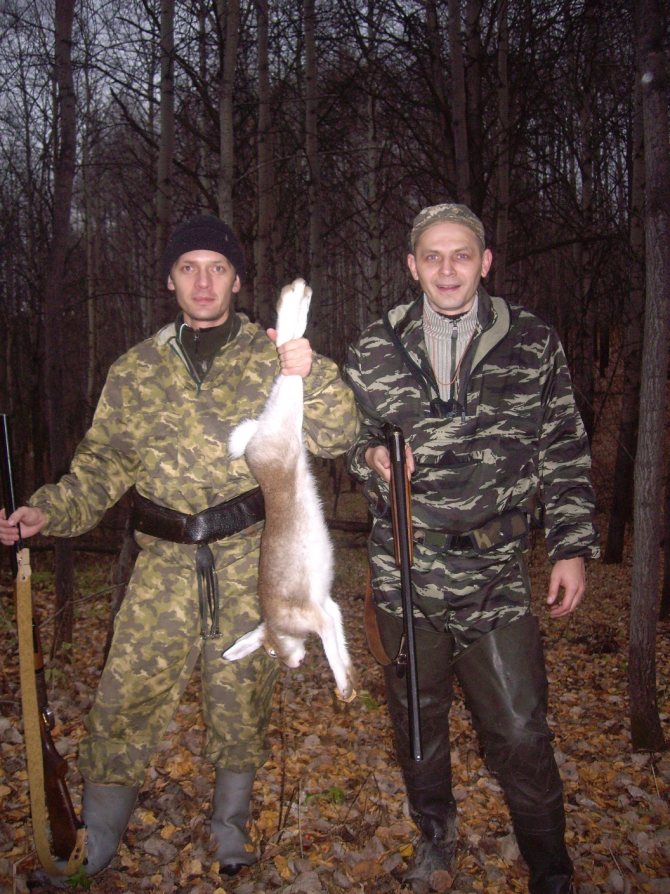
they fell off their beds, which were located closer to the edge and near the trunks of large trees.
The hare usually let the hunter pass, jumping up behind him and trying to go to the opposite side of the forest belt.
In the unplowed fields of harvested sunflowers and corn, we had to move slowly, with frequent stops. At stops you had to listen to where the animal rustled. It is noticed that the hare also stops for the same purpose.
If there are clumps of grass, reeds or weeds near the fields, they should also be examined.
An incident that happened to my father on one of the hunts remains in my memory. Having examined the field and not picking up a single hare, he went out onto the country road. Nearby there was a nursery fence, and between it and the dirt road there was about half a hectare of weeds. Deciding to take a shortcut, the father walked through the weeds. And in this small area he raised four birds with one stone, one after another.
A hare, if he settles in the forest, is in places that are more or less clean. Always avoids thickets and strongholds. In a continuous forest, a hare can only be found near the edges, clearings, and clearings.
This is interesting: Svinushka was previously conditionally edible, but is now classified as poisonous.
In the autumn, when the bushes are exposed, the hare leaves the bush, but returns with the onset of a thaw.
The hare avoids being in thick grass, reeds, on winter crops in the rain and with heavy dew.
During the first winter, hares fatten exclusively on winter crops or in fields with greenery. Hares rarely lie down in these fields, but, as a rule, they lie down near them.
When the first snow falls, the hare actively sheds its coat, putting on winter clothes. In the south, snow does not last long, and nature plays a cruel joke on it. The animal becomes more visible against the background of the dark earth. It becomes possible to hunt hare, as well as hare, “in the wild”.
During the years of warm autumn and winter in the Saratov steppes, it was possible to hunt hares from the approach. Such hunting on arable land is more effective. Using eight-power army binoculars, I studied the fields from a high place. Sometimes it was possible to spot the hare lying down and even approach for a confident shot.
If a hare lies on the plowed land, then its light gray fur gives it away. If the plowing is deep, then more often the hare lies in the furrow between the clods and is barely noticeable. If there are lonely trees, pillars, bushes, boulders on the field, then he tries to hide next to them.
The author managed to approach the hare while lying down to shoot. Almost until the very last moment there was no certainty that the bright spot on the dark background of the plowing was a hare. In the grass I accidentally came across a hare hiding by a stone. Moreover, the hare allowed him to approach almost closely, breaking away only at the last moment.
Sometimes, by going around the places where hares might have been fattened, it was possible to find a fresh trail. However, he got lost while plowing. In this case, a positive result was achieved using a simple technique.
Having followed the lost trail to the places where it could lie down, I seemed to cover the animal. He walked around a circle of steps 500–600 in diameter, making sure that there were possible lying areas left in the circle. If he did not find an exit trail, then the hare often found himself in a circle. Now the confrontation began. Who will notice who first: the hunter - the hare or vice versa.
You need to be especially careful when frost sets in, because... the sound of frozen grass and the creaking of snow are clearly audible, and the hare jumps off its perch far from the hunter.
But whenever and wherever you hunt a hare along the black trail, do not forget that you need to be constantly on alert, examining the entire space around you at 360°. Remember that a hare rises from a prone position with a jerk, in the wind, and in a matter of moments goes to a safe zone.
Expert opinion
Smirnov Alexander Stanislavovich
Wilderness survival instructor. More than 15 years of teaching experience
If the hare's shot did not stop, then it is necessary to continue monitoring the departing animal. More than once I had to witness that a hare, seemingly unaffected by the shot, fell dead after two or three hundred steps.
Therefore, if you believe that the hare is wounded, after a while, continue chasing it. A wounded hare hiding in a ravine, lowland or clump of grass should be pursued, allowing it to lie down for 40 - 60 minutes.
Then he lets you close.
Knowing some of its habits helps in chasing a wounded hare along a black trail. Thus, a hare, even when wounded, often, if not disturbed, does not go far from its place of daily residence.
To move from one field to another, he uses the narrowest isthmus. A ravine, the slopes of which are covered with bushes and sparse forest, the hare crosses along the cleanest place - along a gentle, wide slope.
A hare, moved from its bed, looks for a quiet place in a ravine, lowland, or irrigation canals. Therefore, if there were many hunters in the grounds, then in the afternoon I tried to avoid such places.
A lot has been written about the equipment of hunters on foot hunts. I agree that high rubber boots are best during autumn and winter thaws. In severe frost - felt boots. You need to dress in warm but light clothing that should not restrict movement.
To hunt a hare, the gun must have a sharp and precise action. It should be brought in line with winter clothing. The gun must fit well into the shoulder, which sometimes requires shortening the stock. Sometimes it is enough to remove the summer gaskets from under the shock absorber.
On the first hunts and in the thickets, you often have to shoot short, so it is better to use shot from the second number to the zero. In the right barrel - “two”, in the left - “zero”. In the wilderness, use shot in a container.
Last winter was warm, and the same is expected this year. Maybe the proposed techniques for hunting hares will be useful here and now. I will be happy about this.

Expert opinion
Smirnov Alexander Stanislavovich
Wilderness survival instructor. More than 15 years of teaching experience
Hare hunting is very popular today. There are quite a lot of ways to get it: tracking, “in the closet”, stalking, driving, etc., but, of course, hunting with hounds comes first.
It is based on the fact that hares, pursued by dogs, like foxes, escape from them along certain paths and holes. The hunter just has to choose the right place and make an accurate shot.
There are four species of hares in our country, only two of which are the main object of hunting - the white hare and the brown hare. The main points of the hunting technique with a hound are the same for both species, but due to the different lifestyles there are also their own characteristics.
Types of hares
There are two types of hares living in our country: the hare and the hare. The hare prefers to spend most of its time in the forest. The hare prefers open spaces: fields, meadows, steppes. There are hybrids of hare and hare, they are called cuffs. Tumaks were found both in the wild and obtained when keeping hares in captivity. Tumaks are capable of reproducing and producing viable offspring.
Belyak
The white hare lives throughout our country, from the tundra in the north to the forest-steppe zone in the south. The white hare prefers to settle in forests with meadows, river valleys, and old overgrown burnt areas and clearings. Loves places where coniferous forests are adjacent to deciduous and farmland.
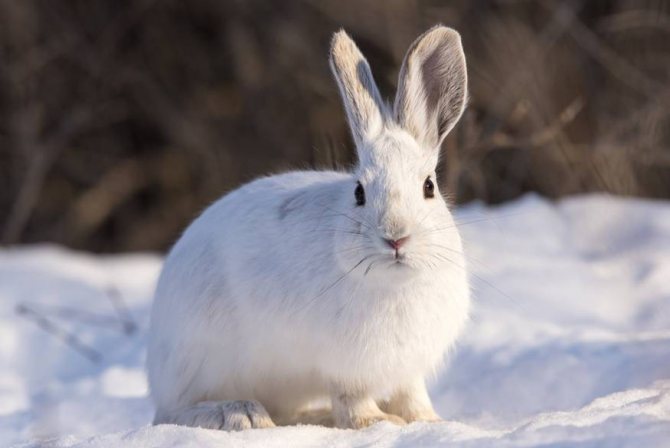
The hare's paws are wide and covered with a thick brush of hair, which allows it to move easily even on loose snow.
The weight of an adult white hare ranges from 1.6 to 4.5 kg. The largest white hare lives in the tundra of Western Siberia, the smallest in Yakutia and the Far East. In the spring, the hare prefers to stay in open places, where the grass on which it feeds appears first; in the fall and winter, it stays in the forest. In spring and summer, the white hare feeds on herbaceous plants, oats and clover in the fields. In autumn and winter, it switches to feeding on shoots and bark of trees and shrubs, mainly willow and aspen.
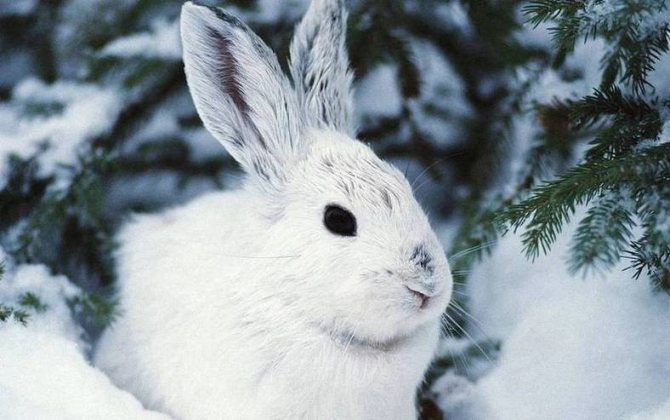
The white hare is predominantly a crepuscular and nocturnal animal, most active in the early morning and early evening hours. White hare feeding begins at sunset and ends at dawn. Having eaten, the hare goes to bed, but before lying down, it carefully confuses its tracks.
A hare can use the same bedding area more than once, but more often the bedding areas are new every day. In winter, during severe frosts, the hare digs holes in the snow up to 1.5 meters long, in which it can spend the whole day.
The hare molts twice a year: in spring and autumn. Molting is triggered by the length of daylight hours, and the speed of molting depends on the ambient temperature. Each part of the white hare's body sheds at a certain average daily temperature. The color of the summer fur of the hare is from reddish-gray to slate-gray with brown streaking. After the autumn moult, in winter the hare's fur becomes snowy white, with the exception of the black tips of the ears, hence its name.
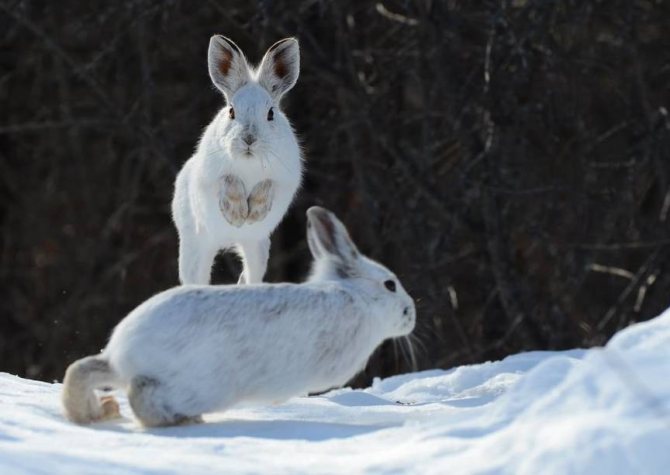
The hare has the best developed hearing, vision and sense of smell are poorly developed; the hare can run very close to a standing person. The main skill of the hare that saves it from predators is the ability to run quickly.
Whites are very prolific animals; in most of their range they breed 2-3 times a year. The first litter of hares is born in mid-April - mid-May, the second litter is born in late June - July, the third in late August - early September. The number of hares depends on the female, can be from 1 to 11, on average in the north there are 7 hares in a litter, in the middle zone and in the south from 2 to 5.
Hare
The hare is an original inhabitant of the steppe, which is currently widespread in the steppes, forest-steppes, tundra and sparsely forested areas of the forest zone. In Russia, it lives throughout the European part of the country to the northern coasts of Lakes Ladoga and Onega and the Northern Dvina. The weight of an adult hare is from 4 to 6 kg, sometimes reaching 7 g. The largest hare are found in the north and north-east of the country.
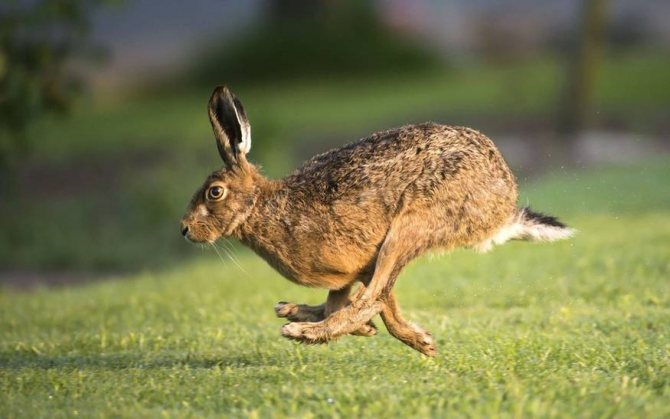
The summer color of the hare is ocher-gray, ocher-red, olive-brown, brown, and brown. Throughout the body there are dark streaks formed by the ends of the undercoat hairs. The ends of the guard hairs are buffy. The winter fur of the hare is slightly lighter than the summer fur. Browns, unlike hare, are never pure white in winter. The hare sheds twice a year: in spring and autumn. In the spring, the hare sheds from head to tail. The peak of spring molting is April. Autumn molting begins in September and ends in November; in autumn, molting goes from the hips to the head, the head is the last to shed.
The hare is an inhabitant of open spaces: fields, meadows, forest edges, clearings, clearings, fires. He especially loves places where agricultural fields alternate with copses, thickets of bushes and ravines. Most active in the first half of the night and in the early morning hours. During the day, it spends time lying down, which most often is a small hole dug under the cover of a bush, under a fallen tree or in tall grass. In summer, during intense heat, it can dig a temporary daytime hole; in winter, it can also dig a hole up to 2 meters long in deep snow.
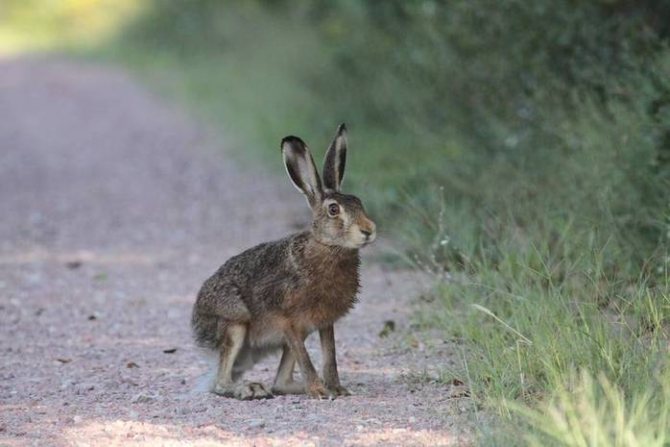
In spring and summer, the hare feeds on young shoots of trees and shrubs, leaves and stems, sometimes digs up roots, and eats seeds. The hare willingly eats vegetables and melons. In winter, it continues to feed on grass seeds, winter crops, and the remains of garden crops, digging food out from under the snow. With deep snow cover, it switches to feeding on bark and shoots of trees and shrubs. In winter, the hare often appears near human habitation near villages, winter fields and vegetable gardens.
The hare has very well developed hearing, but his vision and sense of smell are poorly developed. The hare has well-developed hind legs; in case of danger, they allow him to quickly hide from sight. Rusak can reach speeds of up to 80 km/h. Moreover, while moving, the hare can very sharply change the direction of its run, jumping to the side, which allows it to hide from pursuit. A hare can climb a mountain well, but it flies head over heels down a mountain.
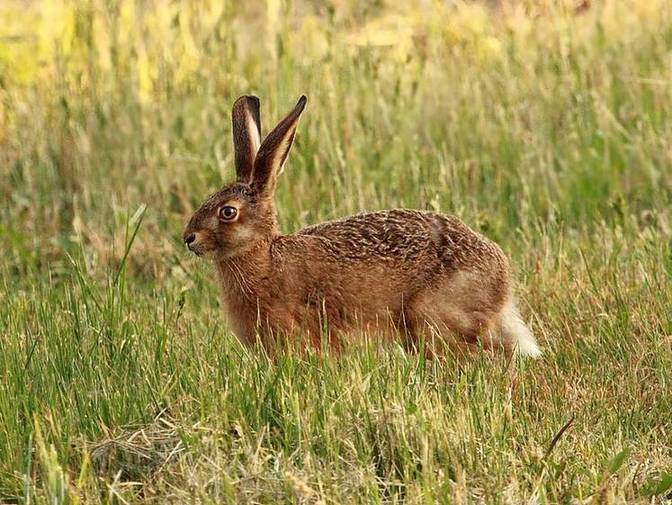
The hare is a very prolific animal. In the north, a female hare brings 1-2 broods, in the middle zone 2-3, in the southern regions with warm winters and early spring there can be 4-5 broods. The number of hares in a brood ranges from 1 to 9. Typically, the more broods there are in a year, the smaller the number of hares in a brood.
White hare hunting
The mountain hare is a forest dweller and does not like open spaces, only on the borders of its range - in the tundra and forest-steppe it can be found outside forest areas, here it sticks to islands of trees and shrubs. At the same time, he avoids forests consisting mainly of coniferous or deciduous trees.
Typical habitats of the animal are mixed forests with abundant deciduous undergrowth and grass, alternating with clearings, clearings, floodplain meadows and swamps.
Hunting with hounds for hares begins in mid-autumn along the black trail and ends in winter with the arrival of deep snows
Some hunters prefer to hunt a hare alone, but in a company of 2-3 people the hunt becomes more interesting and productive. You need to go out with your dog early in the morning; fresh tracks left overnight are easier for the dog to catch.
It is usually carried out on weekends, regardless of the weather, but it should be noted that in wet and windless weather it is easier for the hound to search and further race. The dog's owner walks around the area where a hare may be lying and encourages the dog to search - “scoots.”
A properly raised and trained dog should have a good scent, viscosity, crawling ability, prey ability and, finally, a good voice. Such an assistant independently raises the animal quite quickly; if the hound cannot find a fresh track for a long time, he has to help her with his voice and, moving noisily, scare the hare from its bed.
If successful, you should immediately set the dog on the trail.
To speed up your search, it is important to choose the right route. Most often in the fall, hare can be raised in densely overgrown clearings, burnt areas, near swamps, ravines, unmown clearings, meadows and fields.
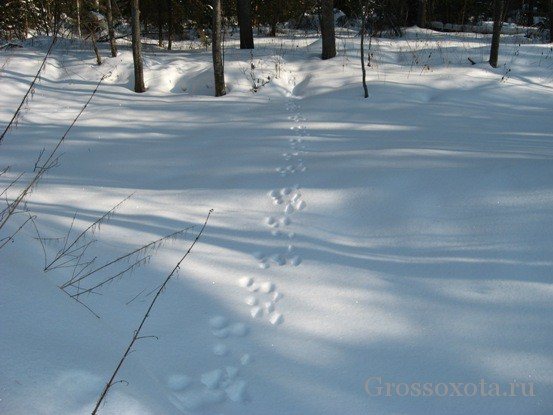
After the hare has been raised, you should try to determine its resting place as accurately as possible. In this place, having made a small circle, it will most likely pass. If there are several hunters, during the course of the rut they stand at other possible places for the white hare to pass - holes.
The best such places are: clearings, forest roads, the outskirts of clearings, clearings and places of forest clumps and tracts adjacent to each other. The animal moves away from the dog pursuing it in circles, passing through its bedding area. If it was not obtained on the first lap, then it goes to the next, passing through almost the same places.
Many factors influence how the hunt turns out. Adult animals make more regular circles than young ones; during the course of the move, they often try to get rid of the pursuit by making doubles, discounts, loops, which often leads to the dog losing the track - a chip.
In this case, you have to wait until she figures out the tracks, and sometimes the hunter puts her on the trail again. With a good hound, especially along the black trail, the hare does not have time to confuse the tracks, so the rut is especially correct.
Some hunters, due to inexperience, hearing the approaching rut, quickly run to intercept it, thereby scaring the hare from the circle; he has good hearing, after which he has to wait for the next passage.
With the arrival of winter, it becomes more difficult for the dog to work; the deeper the snow, the faster he gets tired. Periods when the thaw gives way to frost are very dangerous, the crust of the crust damages the dog’s legs, in this case it is better to give up hunting.
Some shooting tips
How to properly remove the skin from a hare and process it, read in the “Fur” section.
The hare hunting season opens in mid-autumn and ends in winter. In many regions of Russia, hunting for fur-bearing animals begins when the snow is still very far away. This is why many hunters have to use some tricks to get the desired trophy.
This is interesting: Hunting with a drathaar
Of course, hunting a hare in the fall during the thaw is most often found with the use of hound dogs, since hunting along the black trail without a dog is difficult and quite rarely such a hunt ends successfully for most beginners. But more experienced hunters do not neglect this type of hunting, even if they do not have a dog, and it is worth noting that it often ends successfully.
In this article we will look at what hunting a hare in the fall involves, how to hunt along a black trail from the approach and much more.
Useful tips
At the very beginning of the article it was mentioned that every animal carries its own secrets. These secrets, of course, are familiar to experienced, old hunters, but new hunters also want to learn a few useful things at the theoretical stage, which will help them make fewer mistakes later in practice. There are some useful tips when hunting lagomorphs:
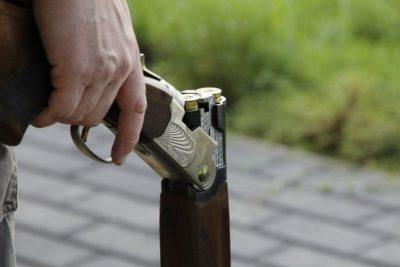
Perseverance and patience are two factors that are worth stocking up on when hunting hares;- Accurate shooting in different positions of the shooter, the skill must be honed as sharply as possible;
- When shooting, the first shot will give direction to the development of the entire situation of the fishing process as a whole. How effective and accurate he is, the hunter himself will be successful;
- Smooth movements in everything - developing the habit of automatism, both when shooting and in the movements of the hunter. Accuracy and caution in hunting long-eared animals are only a plus as a result;
- The effective time for hunting hares is night – the animal’s peak activity, but first you need to hone your hunting skills under simple conditions for catching prey;
- Studying the theory of hunting in principle and for specific game on a maximum scale is mandatory for beginners;
- Safety – don’t forget about it. Warm clothes on the catcher must be of high quality, dry and strong. Firearms are always in perfect condition, and the skills to use them are at the same level.
And the main thing is a pro-active position in terms of morale and maintaining the hunter’s morale in any situation. Even the oldest and most experienced master hunter sometimes returns without the proper catch... But under no circumstances should one become discouraged, give up developing the hunting craft, or despair. If you are unlucky today, you will be lucky tomorrow, no matter what kind of prey you catch.
Patience, perseverance, hard work in acquiring knowledge and skills in practice are a set of qualities that simply cannot fail to bring positive results in any business. Summarizing all of the above, we can conclude that hunting hares is by no means an easy method of catching prey, as it seems to a beginner. Having briefly dived deeper into all the basics of the process of hunting long-eared furry animals, we managed to learn all the subtleties and nuances.
Video on the topic:
Hunting a hare with a drathaar. January 19-20, 2020
27:21
Hares under every bush!!! Hare hunting 2020. Hare hunting.
12:36
Hare hunting. The long-awaited snow fell. Tracking a hare. Toz - 34
13:46
Russian hare hunting with hounds along the black trail! +18
32:45
Previous articleHunting dog breeds - photos and descriptions
Next articlePheasant hunting – types and features
hunter
Uncultivated land
It is worth noting right away that hunting along the black trail on uncultivated lands is the most difficult, since the hare has significantly more places to lie down, and your visibility, in turn, is significantly reduced.
Therefore, be prepared for a long walk. It is worth noting that in such places the animal is in most cases not frightened, and if you walk a few meters from the hare, you may simply not notice it. Shuttle walking is most effective in such places.

Farmland
Expert opinion
Smirnov Alexander Stanislavovich
Wilderness survival instructor. More than 15 years of teaching experience
In farmland, hare beds can be found in the most unexpected places, so when hunting from the approach you should always be extremely careful. Beds are most commonly found in overgrown field margins, planting edges, and corn and alfalfa fields.
Sometimes the “slanting” one can even be found in a plowed field not far from the remains of winter crops or grass. Unlike hunting in uncultivated areas, here it is better to track the hare with a team of several people.
How to shoot a hare?
For hare hunting, my friends and I usually equip cartridges with shot numbers 3 and 1. The first shot from a half-shot (cylinder) is a cartridge for short distances.
Usually this is a cartridge with number 3 shot, without a wad container, and in some cases (where you have to shoot quickly and short, for example near farms and in gardens) - a dispersant. The second shot is a long-range cartridge: shot number 1 in a wad container.
The desired gun is light and well adjusted to the hunter.
Expert opinion
Smirnov Alexander Stanislavovich
Wilderness survival instructor. More than 15 years of teaching experience
I am against the early opening of hare hunting. Apparently, the concept that has been deposited in my head since childhood that you can follow hares and foxes from the beginning of November does not allow me to think differently.
I am against the early opening of hare hunting. Apparently, the concept that has been deposited in my head since childhood that you can follow hares and foxes from the beginning of November does not allow me to think differently.
For example, in the current season, hare, fox and wolf can be hunted from September 15. It’s possible, but is it necessary? But what about the deciduous plants that are just emerging at this time? So, shooting a nursing hare will not be a violation of hunting rules?
In my opinion, this only benefits those who like to chase animals from under the headlights, so that a hare in the trunk of an SUV is not a reason to draw up a report. I don’t even want to talk about the quality of fox skins in September. That’s why I took the vouchers, but I’m going duck and woodcock fishing, which really is the right time!
However, even in November, the discovery of fur-bearing animals did not always take place along the white path. But not everyone knows how to find a hare when there is no trace.
Of course, the easiest answer to the question of where you can raise a brown hare is: everywhere! I had to drive him out from under a pile of broken slate, from the rubble of bushes, from under a combine broken in the field, from under the porch of an abandoned house. The Russians jumped out from under the diesel fuel tank, from the windows of the old cowshed, from under the barge rusting on the shore.
And yet I am used to looking for a hare in more typical places.
If I have to hunt alone, I go combing the slopes of ravines covered with burnt grass. Moreover, the hare can settle down for the day both at the top edge and at the very bottom. There is no need to rush here; you need to carefully check all the “suspicious” places, not being lazy, “hook”, stopping for a short time.
I was repeatedly convinced that the hare, lying very “tightly” at this time, jumps out exactly at the moment when the hunter stops. If you have binoculars with you (and everyone should have one when hunting in open areas), you should periodically inspect the surrounding area.
There are a lot of interesting things to see! In addition to the opportunity to admire a mousing fox and a flock of black grouse perched on a lonely birch tree, binoculars will eliminate unexpected encounters with competitors.
If on my way there is a field with deep plowing, and even interspersed with straw, I will certainly turn into it. Yes, of course, it is very inconvenient to walk along it, but it is precisely on such a field that the hare rises most often.
And even such a bright and seemingly noticeable animal as a fox flies out of deep plowing literally from under your feet. Then you’re just amazed – how did you not notice it before?!
Russians love to lie down in dry field marshes. It is here, among the hummocks covered with withered vegetation, that its reddish skin is completely invisible. From a swamp measuring 150 by 100 meters, our company was lucky enough to once raise four birds with one stone! True, that was twenty years ago, but that was
The hare is a great master of mimicry. Wherever the scythe settles down for the day, his “outfit” will certainly blend in with the surrounding area.
In different weather, the behavior of a hare while lying down varies significantly. In calm, clear weather with a slight frost, it easily flies out of the rest, sometimes out of range. As always, the hare strives to get up, seizing the moment when the hunter turns his back to him. Only a light rustle of dry grass can serve as a signal that the beast has risen.
In cloudy, windy weather, and even with precipitation, the hare needs to be “picked out” from its resting place with a boot. Everyone in our company remembers the incident when, while approaching a duck swamp, one of our friends stepped on a hare. Ooo! You just have to imagine it: waist-deep grass, everyone is careful, so as not to make noise, sneaking towards the swamp.
The reeds are about to burst with the “applause” of duck wings, and you will need to instantly identify the target and hit it with a well-aimed shot. And at that very moment my foot lands on something living, which instantly jumps a meter off the ground! A cry of amazement, a hasty, hectic, harmless doublet, and the culprit of the commotion himself, running away as fast as he could across an open field.
And of course, choice swearing that justifies the involuntary fear, and healthy, tearful laughter from the participants in the action.
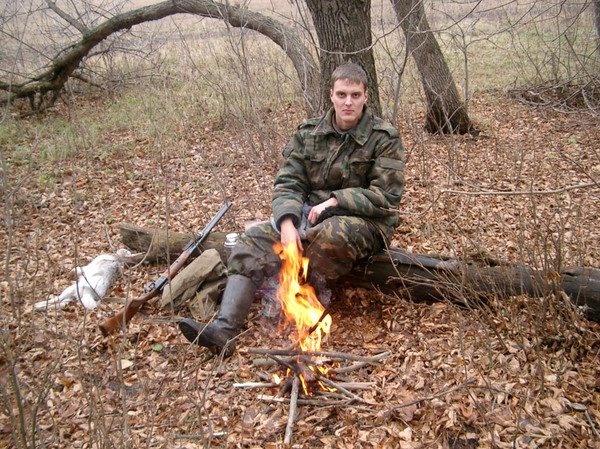
Seeing a hare lying down is the greatest luck. With forty years of hunting experience, I managed this only three times.
For the first time, when I was a boy running to my native Dubrovo, I saw a hare lying down on the very edge of a meadow swamp. I didn’t have a gun with me, since the youth hunting license had an entry: “The hunt should be carried out under the supervision of my father,” and this was sacredly observed.
So I crept up to the hare ten meters and joyfully clapped my hands. The hare took off running, and I was very proud of myself that I was able to sneak up on the hefty hare for a sure shot.
The second time, through the powder, we trailed the big-eared ones with our friend Mikhail. The trail approached a small pile of straw and disappeared.
This is interesting: Fire in the apartment: causes and your actions
I climbed onto it and saw a little little mermaid hiding right at my feet. And the third time this happened in the same Dubrovo, which is a ravine with a river and alder and oak groves.
I noticed a hare in a hole between two oak trees. He jumped out instantly as soon as my gaze settled on him.
If you hunt in a group, the chances of getting a hare up the black trail are much greater. There are two main methods: chain and corral.
Both the first and second methods have their pros and cons. By combing open areas and ravines, it is possible to cover a large area.
In addition, you are always in the zone of visual contact, and all events happen before your eyes. Often, a hare picked up by one of the hunters is shot by a partner.
But if the hare managed to realize in time that the danger did not come from one source (and this happens quite often), he manages to escape safely.
When hunting in a pen, a hare that leaves without a shot (or after a miss) is more likely to be shot by other members of the team. For the drive, we (when hunting with three of us) drop off (pick up) one beater at the beginning of the intended segment (the same ravine), and we ourselves go 3–5 kilometers further.
We block all promising openings of the animal and patiently wait for the beater. With this method of hunting, the fox becomes our prey more often than a hare.
If there are dogs, they, of course, go with the beater.
Expert opinion
Smirnov Alexander Stanislavovich
Wilderness survival instructor. More than 15 years of teaching experience
I really like abandoned villages for such hunting. There are quite a lot of these in our times, and the hare (just like the fox) willingly stays in them. It is in such places that you can enjoy the work of hounds.
People may object to me: what about the forest? After all, the most wonderful black trail hunt is in the forest! Yes, everything is so (it once was)! Of course, in the absence of snow, the hare walks under the hound in small circles. But where is he - the white hare? In my opinion, he cannot withstand competition with a wild boar.
You can, of course, say that epizootics are to blame for the decline in hare numbers, but I believe it’s pig farming!
Where can you find forests where you will be allowed to hunt white hare with a hound? Here's to the wild boar - please! I know hunters who, having acquired a license for a wild boar, which justifies being in the forest with a weapon, hunt a hare.
But this has nothing to do with the stated topic of the article.
Trying hare meat, sewing excellent white mittens or simple sporting interests - these and other goals guide avid hunters. But do not think that the hare will wait under the nearest pine tree and calmly allow itself to be found.
On the contrary, these animals have extremely acute vision, capable of catching the most imperceptible movements of their pursuers, and a pair of fast paws. So hunting hares is not only an exciting activity, but also quite difficult.
Fortunately, numerous generations of hunters of these eared creatures also did not waste time and managed to invent a single effective way of hunting hares. In this article we will look at several methods of hunting without a dog.
One of the most popular is hunting by drive, that is, collectively.
Hunting in Tatarstan
Autumn has arrived and the hare hunt has begun. Hunters with hounds are doing their best to hunt hare and fox. Hunters without dogs were much less fortunate. Firstly, not all hunting grounds give the right to hunt without dogs along the black trail. Secondly, hunting a hare along a black trail without a dog makes no sense, as many hunters (especially beginners) think. But there will always be people who will refute these dogmas.
I discovered this type of hunting for myself quite by accident, although in my youth in the village, having read Bianchi’s books with a neighbor, they chased russians through plowed fields, the so-called Uzerka hunting (but more on that later).

So, mid-October. Central part of Tatarstan. The main target is black grouse. On the first day I caught about 15 black grouse and at least one koscha!!! All are diggers; according to the unwritten hunting laws, we don’t shoot them. I systematically walk around promising places and suddenly pick up a hare. Alas, I don’t have a license in hand. We have been hunting in these places for 2 years now, but we have not seen a hare yet. Lucky! But next weekend we have a license in hand and there are 3 long days of holidays ahead! All promising places are marked on the Google map, the tactics have been chosen, all that remains is to check it. As a result, the right hunting areas and strategy made it possible to close the hunting license alone in 3 days and catch three hefty hare.
Now let’s learn more about the tactics and features of hare hunting in Tatarstan (when I say hare, I mean hare). Tatarstan is famous for its agriculture. Therefore, its large area in October consists of arable land, winter crops and fields with harvested corn, sunflowers and sometimes beets. Nowadays, agricultural workers are armed with powerful German machines, so the equipment does not linger much in the fields, which does not bother wild animals so much. Vast fields are separated by plantings and ravines; sometimes on the fields themselves there are isolated thickets of willow, stakes and unplowed areas with marshy areas. These are all places that interest us.
Habitat of the hare.
The first type is uncultivated land.
If for some reason agriculture in any hunting area does not flourish, there are much more places for the hare to lie down and hunting turns into hard work. Here, endurance and perseverance coupled with shuttle walking will bring success. Make the shuttle in increments of no more than 20-25 meters, because The hare usually sits firmly in the grass, can let the hunter pass, and quietly leave, so that you won’t even know about his presence, only if you accidentally stumble upon a bed. Usually we use the map to identify in advance places suitable for the hare to rest. Basically, these are small areas overgrown with willows, young birches, aspens and pine trees along the edges of large ravines. Along with the hare, black grouse also lives here.
A typical roosting place for a hare is in uncultivated fields.
It is worth noting that most of these hunts involve great physical exertion and often require walking 25 km in a short autumn day. over very rough terrain. because Not all interesting places are accessible by car. As I already said, having found the approximate location of the hare, we go into it against the wind and with a shuttle, grasping the edges of the thickets, we comb the area. In my tactics, I stop for 3-4 seconds every 50-60 meters, deliberately making the last 2 steps loud. This trick was suggested to me by Ilyas Abiy, a game manager at the Atkanysh hunting estate. True, in the original everything was exactly the opposite, i.e. In order not to frighten off the hare, you must not stop and, having reached the expected place of the hare’s resting place, you must mark time. I do the opposite on the black path, because... the goal is to “squeeze out” the tightly lying hare and lift it. At the same time, you must control 360 degrees around you and always be prepared for an unexpected rise.
I’ll say right away that despite the apparent difficulty of hunting in the first type of land and vast spaces, hunting here is most effective, especially for a lone hunter.
The second type of land is farmland.
In such areas, the hare chooses different places to lie down and can be found in conditions completely unexpected for the hunter. But still, the most characteristic stations are: forest plantations, stakes and edges of plowed fields overgrown with weeds, alfalfa and harvested corn fields, a roughly plowed field. It happens that a hare lies on the most plowed field near the remains of grass and in winter crops, which, due to the warm autumn, have risen to a height where a scythe can hide in them. Or it could be turnout in the field, the remains of last year's straw. In general, in such conditions the hare has somewhere to hide from the hunter. Therefore, for a successful hunt you will need a team. Only an experienced hunter can detect and outwit a hare alone. But beginners should not despair, patience and work will grind everything down! At the same time, you will have invaluable experience behind you.
Let's take a closer look at each case.

So, in front of you is a forest plantation separating 2 vast fields or planted along the edge of a ravine. The hare in the planting loves a thin “undercoat” of birch trees or young aspens. Particular attention should be paid to islands of tall grass. To comb this area with the greatest benefit, the effort of 3 hunters will be needed: two walk along the edge of the planting, one goes inside. There is no need to create much noise; a little tapping on tree trunks and periodic stopping of the beater will suffice. It is better for all participants in the hunt to walk on the same straight line.
Pegs in winter fields or arable land are the hare's favorite place to lie down. Here he manages to outwit the lone hunter in most cases. If the pegs are small, the effort of three hunters is enough: two stand so that there are no “dead” zones during shelling, the third enters the peg and pushes out the hare (often the fox also gets hit by shots). Some features of such a hunt. Firstly, don’t come closer than 30-40 meters to the peg! Secondly, two hunters walking along the edge should, as it were, capture the area “in pincers” so that the approach is at 90 degrees to the forest and stand opposite each other relative to the middle of the stake. Otherwise, a “dead” zone will form on one side, into which the hare can successfully sneak through. So, two hunters synchronously approach the edge of the fragment at 30 meters and give the command to the beater to enter. The hare can run out in any direction, so you need to be extremely careful. Thirdly, you should never get everyone together before the next paddock.

We do not forget about precautionary measures when hunting collectively, so under no circumstances do we shoot in the direction of the forest.
The edges of fields overgrown with weeds, or areas near them with small undergrowth of trees, can be searched by one hunter.
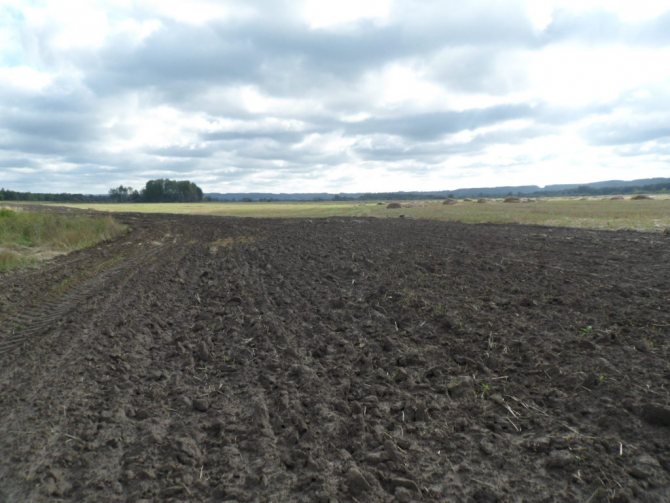
Alfalfa, harvested corn or sunflower fields, roughly plowed lands are suitable for combing by a large company; such areas are very difficult for one hunter to cover. Successful hunting can only be done on arable land “in the wild” when the hare has already turned white and the snow has not yet fallen or melted due to warm weather.
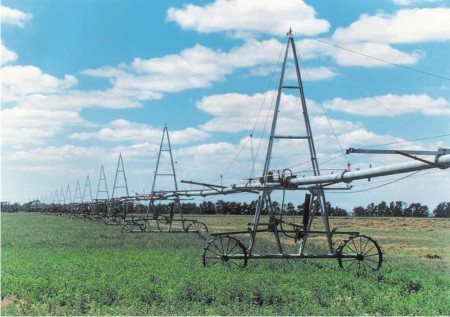
The fields with the Volzhanka type sprinkler , which some agricultural enterprises still have, stand apart What is especially interesting is that they “park” this “car” every year in the same place, which is overgrown with weeds and tall grass. “Parking” is a plot of uncultivated land from the center of the field to one of the edges and up to 4 meters wide. This is one of the most promising hare havens. Typically, “Volzhanka” equipped fields sown with beets, potatoes and other vegetables, which are a delicacy for the hare. Even after recycling these cars, sometimes there remains a “parking” lane. Don't pass these places!
The third type is abandoned gardens, holiday villages, outskirts of villages, abandoned farms, summer camps for grazing livestock.
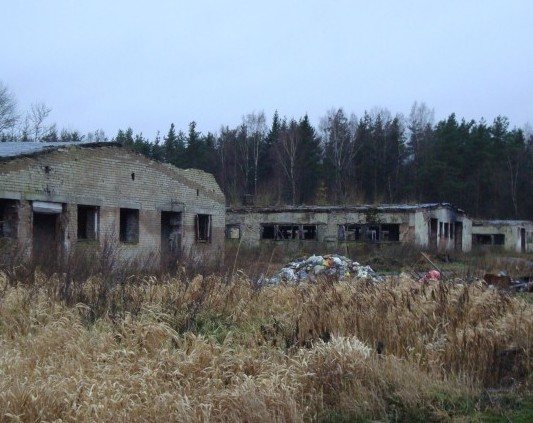
Personally, I think these areas work better on the white trail, except for summer camps. At least in October it is much more difficult to raise a hare here, because... There are a great many places for a hare to hide here. These include weeds near farms, dachas and fences, and abandoned buildings, bushes, tanks, edges of silos, etc. and so on.
Near summer camps for grazing livestock, hunting for hare can be very productive. Typically, cows are returned back to farms before the beginning of October, leaving behind piles of silage, haylage, scattered forage, remains of grain crops, and pieces of rock salt. All this attracts hares from the immediate surroundings and during feeding time you can meet 3-5 hares here. They, of course, scatter in the morning, but only 1-2 hares remain to lie down. They often lie near feeders and fences. You can hunt either alone or with a group. If alone, I start from the edge of the nettle and wormwood thickets that usually surround the camp. Next, we spiral towards the middle. Be sure to walk along the perimeter of the fence and near the feeders.
So we looked at typical hare bedding areas and hunting tactics in them.
Some short conclusions:
1). We always go (try to go) against the wind!
2). Make stops for 2-3 seconds
3). When we see a lying hare, we mark time and under no circumstances stop!
4). We cover large areas by shuttle from edge to edge
5). We discuss in advance how the corral will work when hunting in stakes
6). Brightly colored caps or vests are great when hunting as a team, so you can see exactly where your colleague is standing or walking.
7). The hare rarely lies on the highest place, preferring slopes
How to shoot a hare?
For hare hunting, my friends and I usually equip cartridges with shot numbers 3 and 1. The first shot from a half-shot (cylinder) is a cartridge for short distances. Usually this is a cartridge with number 3 shot, without a wad container, and in some cases (where you have to shoot quickly and short, for example near farms and in gardens) - a dispersant. The second shot is a long-range cartridge: shot number 1 in a wad container.
The desired gun is light and well adjusted to the hunter.
How to take a lead on a hare.
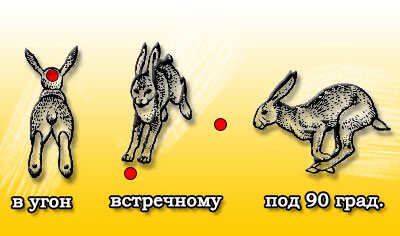
To be continued.
Especially for www.tathunter.ru
Azat Khamidullin
Copying without permission is prohibited!
Share link:
Collective driven hunt
To hunt hares using the driven method, the brigade is divided into two groups: beaters and shooters. The first ones pass by the hare's beds with the maximum possible noise, tapping with sticks, twirling rattles with a loud cry. In this case, frightened hares rise from their beds and run straight to the numbers.
Hunting a hare in a chain a - chain; b - forest chain; c - chain with flanks; 1 - beater; 2 - shooter; 3 - hunt leader
It is best to hunt in this way in frosty autumn weather along the black trail: then the long-eared comrades sit very sensitively, ready to instantly leave their settled place - a feeding swamp, for example. But in warmer weather, white hares (they are hunted in early winter) are difficult to lift, and no amount of ratcheting will help.
In the midst of winter, hunters switch to hare, which like to make themselves comfortable somewhere in bushes, ditches overgrown with grass, or among stones. In such places it is quite easy to notice the danger.
Having attacked the hare's trail, and making sure that the tracks do not go beyond the shelter, the shooters and beaters surround the hare's shelter and take opposite positions. Well, then everything happens according to the old scheme.
Circular pen 1 - beater; 2 - shooter; 3 - hunt leader
They say, by the way, that the hare is very fast, while his white relative (phlegmatic, apparently by temperament), in absolutely no hurry, runs out right in front of the shooters, which they take advantage of. However, even not very smart hare can leave you with your nose if the hunters do not move in an organized manner, and “holes” appear in their chain through which the prey finds a way to escape. This occurs due to ignorance of the basic rules of behavior in a chain: navigate by the rear neighbor in the group, the distance between hunters should be no more than 60–70 meters, and so on.
Hunting alone can be done in several ways: from the approach and from ambush.
How to hunt a hare from the approach?
Typically, such hunting is carried out in the winter season, when snow has already fallen. For example, you can simply follow a hare's trail and then find its owner. This method is called “trapping” or hunting in the wild.
Expert opinion
Smirnov Alexander Stanislavovich
Wilderness survival instructor. More than 15 years of teaching experience
It is best to track hares after fresh snow falls at night (it is also called powder), and the later the snowfall ends, the less you will have to understand the intricacies of tracks in the forest.
Having reached the feeding site, you should not try to unravel the many “patterns” left by the hare, but simply try to find the exit trail by making a small circle with a diameter of 50–100 meters around the feeding site. Yes, and get ready for the fact that the cunning animal will certainly confuse its possible pursuers with jumps to the side and loops.
Sometimes, however, you can find “dead” powder, when only the freshest traces remain uncovered, and then the prey is somewhere very close.
However, even if this is not the case, the hunter, while following the trail, must look around and pay attention to all possible hiding places of the hare, and be always ready to shoot. Otherwise, the hunter simply will not notice the moment when the prey jumps out and snatches it from under his nose.
Although failure should not embarrass the unlucky hunter: if hares do not often encounter hunters at the feeding site, the departed animal may return after a few hours.
Hunting for a hare in the snow by tracking
This method consists of following a malik (fresh trail) to the hare's resting place, picking it up and trying to kill it with a bullet. In this case, not only a fairly open area is important, but also the ability to read hare tracks. And you will find a lot of them, even if there are few animals in the vicinity.
It is worth following the trail only in the morning, in the worst case – at night. Sometimes even experienced hunters find it difficult to figure out when traces are left, so they hunt a hare by tracking after powder or heavy drifting snow. As a rule, at this time only the freshest hare tracks remain in the snow.
So, the powder has fallen, let's go hunting. We must remember that the hare is a cunning animal that will always try to confuse its tracks. He can walk along them in the opposite direction, he can throw himself to the side, he can lead you along a well-worn road for some time, and from there make a jump into the nearest bushes - to where it will be very difficult to find his trace.
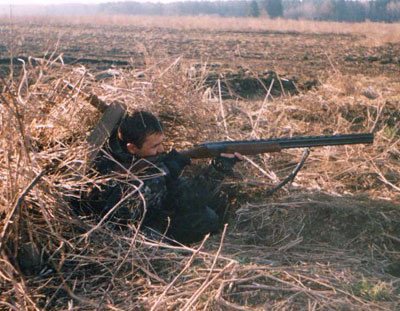
In order not to complicate your task, you need to walk not along the trail itself, but nearby, without stepping on it. At the same time, you need to concentrate your gaze not only by looking at your feet, you also need to constantly raise your head and peer into the horizon line. The hare very often, after tangling the trail, returns back and arranges a lie near the places where it passed before. Therefore, do not get so carried away with the process of walking along the trail that you do not notice the oblique one running away from under your nose.
For a successful hunt, you need to look closely at all suitable places for shelter. At the site of the hare's fat, you should not look for any logical explanation for the huge number of tracks, just go around them in a circle and find the trail that comes out. This way you will reduce your search time.
When twos, threes or discounts start appearing along the route, stop and take a closer look at the area. Already somewhere here there may be a beast lying down that is capable of rising at any second. At the same time, he may turn out to be in a completely different direction from your search, and even running away.
As a rule, in warm and windy weather the hare allows the hunter very close to him, but in cold weather he stands far away. If the animal is slightly frightened or not even shot, it will lie down nearby. Therefore, after letting him rest, you can continue tracking in order to approach the shot.
During a winter hare hunt, the hunter learns a lot about the habits and way of life of the animal by tracking. Not only is this interesting, but it can also be useful when you hunt in other ways.
